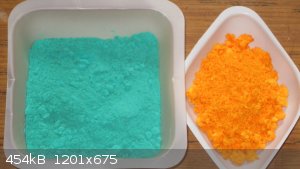I tend to fall into the Woelen camp. I don't think that the blue compound is a nitrite ester of glycolic acid because:
a) organic nitrite esters are generally colourless or pale yellow and the later colour is probably due to NOx resulting from hydrolysis.
b) organic nitroso compounds tend to be blue/green. Simple aliphatic nitroso compounds tend to have a short half life; they rearrange irreversibly
into oximes. So for example nitrosomethane (blue) CH3NO rearranges to formaldehyde oxime CH2=NOH this compound then polymerises to a trimer, both are
white.
c) when nitrous acid interacts with some organic compounds "isonitroso" compounds form. These may be colourless, pale to dark yellow or orange.
Isonitroso compounds are in effect ketone oximes. So for example nitrosation of acetophenone yield yield 1-phenylethandione-2-oxime (so-called
isonitrosoacetophenone) and it is colourless.
Another interesting example of this type of reaction I discovered recently when I nitrosated 1-phenyl-3-methyl-5-pyrazolone and
1-phenyl-2,3-dimethyl-5-pyrazolone (antipyrine). The former yields the orange 4-oxime of 1-phenyl-3-methyl-pyrazol-4,5-dione (ie an isonitroso
product) while the latter yields a blue 4-nitroso compound (see picture) because the mobile imino hydrogen has been replaced by a methyl group and
this effectively limits tautomeric rearrangement.
 The blue nitroso and orange isonitroso compounds The blue nitroso and orange isonitroso compounds
So it looks to me like the compound that forms from glycine is a simple nitroso compound. Its low melting point (liquid at room temperature) and
mobility support this idea. So there seem to be two possibilities, nitrosoacetic acid or possibily through decarboxylation, nitrosomethane. The later,
however, as already mentioned has a short half life (tens of minutes at room temperature) and rearranges to a colourless product so seems unlikely.
Then there is the chemplayers observation about the tendency of the compound to rapidly penetrate latex gloves, this tends to suggest a small, weakly
polar molecule (eg dichloromethane penetrates latex rapidly formaldehyde does not). I find it hard to believe that a nitrosocompound with a bulky
polarised -CO2- or -CO2H group attached would have this property which again suggests decarboxylation.
So; in summary I think we are looking at a either a nitrosonitromethane or a chloronitroso(+/-nitro)methane all of which would seem to agree with the
quotation posted by Polverone above.
Somewhere in my files I have a paper about geminal chloronitroso compounds, I am trying to find it at present and will post it if I do.
|